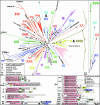New insights into myosin evolution and classification
- PMID: 16505385
- PMCID: PMC1533776
- DOI: 10.1073/pnas.0506307103
New insights into myosin evolution and classification
Abstract
Myosins are eukaryotic actin-dependent molecular motors important for a broad range of functions like muscle contraction, vision, hearing, cell motility, and host cell invasion of apicomplexan parasites. Myosin heavy chains consist of distinct head, neck, and tail domains and have previously been categorized into 18 different classes based on phylogenetic analysis of their conserved heads. Here we describe a comprehensive phylogenetic examination of many previously unclassified myosins, with particular emphasis on sequences from apicomplexan and other chromalveolate protists including the model organism Toxoplasma, the malaria parasite Plasmodium, and the ciliate Tetrahymena. Using different phylogenetic inference methods and taking protein domain architectures, specific amino acid polymorphisms, and organismal distribution into account, we demonstrate a hitherto unrecognized common origin for ciliate and apicomplexan class XIV myosins. Our data also suggest common origins for some apicomplexan myosins and class VI, for classes II and XVIII, for classes XII and XV, and for some microsporidian myosins and class V, thereby reconciling evolutionary history and myosin structure in several cases and corroborating the common coevolution of myosin head, neck, and tail domains. Six novel myosin classes are established to accommodate sequences from chordate metazoans (class XIX), insects (class XX), kinetoplastids (class XXI), and apicomplexans and diatom algae (classes XXII, XXIII, and XXIV). These myosin (sub)classes include sequences with protein domains (FYVE, WW, UBA, ATS1-like, and WD40) previously unknown to be associated with myosin motors. Regarding the apicomplexan "myosome," we significantly update class XIV classification, propose a systematic naming convention, and discuss possible functions in these parasites.
Conflict of interest statement
Conflict of interest statement: No conflicts declared.
Figures


Comment in
-
Multiplying myosins.Proc Natl Acad Sci U S A. 2006 Mar 7;103(10):3498-9. doi: 10.1073/pnas.0600045103. Epub 2006 Feb 28. Proc Natl Acad Sci U S A. 2006. PMID: 16537440 Free PMC article. No abstract available.
References
Publication types
MeSH terms
Substances
Associated data
- Actions
- Actions
Grants and funding
LinkOut - more resources
Full Text Sources
Other Literature Sources

